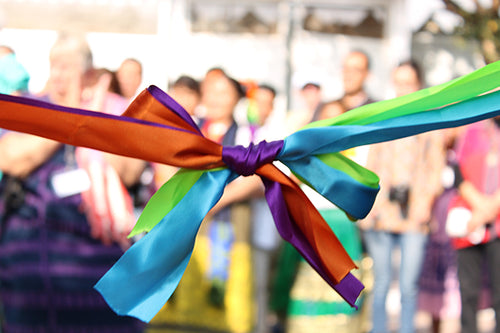
Ernestina Tomas Silva, Ahuiran, Michoacán
Originating in Persia and India, the rebozo or Mexican shawl was introduced to the Spanish during the Moorish conquest of Spain, then brought to Mexico by the Spanish. While the garment was called chal in Spain, Mexicans invented their own word, rebozo, from the verb arreborzarse, to cover oneself. Over the years the Mexican shawl lengthened, narrowed, and borrowed influences, including ikat or tie-dying weaving techniques, from shawls brought from China, the Philippines, and India aboard Mexico's Manila galleons in the 16th and 17th centuries.
A 1582 royal decree forbidding the wearing of indigenous clothing by mestizas, mulatas, and negras further quickened the rebozo's rate of adoption. By the late 19th century the “rebozo” had become the symbol of Mexican womanhood and, like the native woman’s huipil or tunic, identified the wearer's region or village by its color, arrangement of stripes, fabric and fringe type. The way a woman draped it around her could even indicate her marital state, perhaps availability. The most common type of rebozo is of rayon or cotton with a tie-dyed “paloma de bolita” pattern, so the rebozo shimmers or looks as though sprinkled with sugar.
Ernestina Tomas Silva was born May 18, 1962 in the small pueblo of Ahuirán, an indigenous community close to Paracho, Michoacan. Ernestina is married and her daughter, Brigida, is carrying on the weaving tradition in the family - she has also won prizes for her work.
In 1978, Ernestina began an apprenticeship to learn to weave rebozos (shawls) with Patakua Textiles. At first, she used the more economical acrylic yarn to weave her rebozos. Her teacher taught her the first steps and her work rapidly improved. Weaving on the traditional backstrap loom, Ernestia often uses artisela (synthetic silk) to embellish and enhance the color in her rebozos. For the next ten years the quality increased and in 1988, Ms. Pascual Epiphany Silva helped Ernestina take her work to yet a higher level. There are only a handful of rebozo weavers left who use the ancient backstrap loom called a telar de cintura or telar de otate. Since they can only make one rebozo at a time, the work is costly and time consuming (see photos below).
In 1990, she entered her first art show on Palm Sunday in the city of Uruápan, Michoacán. She was awarded First Place in the regional Purépecha category. That same year in September, she won a First and Second Place at a show in Ahuirán, her birthplace. At another show in Pátzcuaro during Día de los Muertos (Day of the Dead), Ernestina captured the Best of Show award which was presented to her by the governor of Michoacán.
She has continued to win prizes for her amazing weaving and is grateful to her beginnings with Patakua Textiles. The quality of the pieces and the arduous work involved make them costly. Their true value, however, is hard to estimate, not only in terms of the beauty of the work but because they constitute examples of an exquisite art which, thanks to the interest of these artisans, has not yet been lost to only be seen in books or museums.
Today, women in all walks of life use the rebozo in Mexico. Women use their rebozo on cold mornings, wrapping them snugly about their necks and shoulders. As the day warms, the rebozo may be folded into a convenient square pillow and placed on the head as a headdress, available when needed. The rebozo is used to protect the back of the neck from a blazing noonday sun, a little of the rebozo may be released to hang to the shoulders behind. The rebozo is used to carry infants - keeping them safe, close and warm; to carry products to market; as a functional headdress; and to embrace a woman's shoulders in life and often as she sleeps her last sleep.
What sets the Mexican rebozos apart from shawls found in other countries is the very fine work of the endings called flecos, puntas or rapacejos. The finished rebozo is removed from the loom with a few feet of threads hanging from each end. The threads, 1,800 to over 5,000, are imaginatively and intricately worked into knotted patterns according to ancient designs (see photos below). The work is almost exclusively done by women known as empuntadoras, and can take weeks or even months to complete.
Calle Benito Juarez
452 520 4168
guiramtom_23@hotmail.com
Ahuiran, Michoacán

